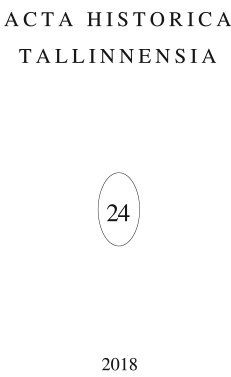KALA TÄHTSUSEST KAUBANDUSES, MAJANDUSES JA TOIDUMENÜÜS 13.–16. SAJANDI EESTIS
ON THE IMPORTANCE OF FISH TO TRADE, ECONOMY AND DAILY MENU IN ESTONIA IN THE 13TH TO 16TH CENTURIES
Author(s): Inna Põltsam-JürjoSubject(s): History, Economic history, 13th to 14th Centuries, 16th Century
Published by: Teaduste Akadeemia Kirjastus
Summary/Abstract: Estonia has historically been rich in sea and lake fish. Already in prehistoric times subsistence fishing played an important role in the life of the inhabitants. Due to the development of agriculture, the economic importance of fish declined. However, in the Middle Ages the demand for fish grew again, fish trade made rapid progress and even achieved transregional dimensions. Already the first medieval chronicles containing descriptions of Estonia praise its fish abundance. During the medieval period fish became so important that access to fishing waters was a significant factor shaping the development of local settlement. Throughout history, the consumption of fish was influenced not only by its availability, but also by attitude, prejudices and beliefs of the people. Alongside with the spread of Christianity in Europe the proportion of fish in the daily menu increased. This resulted directly from the fasting rules of the medieval church. Namely for that reason fish dishes occupied a special place in the medieval diet. Fish was certainly a very important food because it was easily available, it was practically caught all the year round and it was relatively cheap. Moreover, eating it was not regulated by religious restrictions. Quite the contrary, due to the strict fasting rules of the church fish was inevitable in the diet of medieval people regardless of one’s social status. After Christianization in the 13th century, fasting became an obligatory norm in Estonia as well. In the Middle Ages a part of Estonia’s population practiced fishing. Not only natural fish waters were used, written sources also speak about fish rearing. There were fishponds near abbeys, castles of the Teutonic Order, as well as in towns. As daily food, fish was consumed in large amounts and assortment. Baltic herring was the most important fish caught from the sea. In the medieval period salted Baltic herring became a common food for Estonian peasants. On the one hand the rules of the Lent, on the other hand the relative cheapness of fish compared to meat were the reasons why it had such an important place in the daily menu of medieval people. Fish occupied an important place in the internal trade of medieval Estonia, but it was also imported and exported (lamprey, eel, salmon etc.) by Hanseatic merchants. Mainly salted herring and dried cod were imported and consumed in Estonia. The assortment of local fish on sale was remarkably rich: Baltic herring, salmon, cod, smelt, flounder, lamprey, sturgeon, pike, eel, bass, bream etc. Fish spoiled easily, and that was the reason why people mostly ate salted or dried fish. However, trade in living fish has been mentioned in written sources as well. The Reformation abolished the requirement of fasting, but the tradition that had taken root in people’s consciousness did not disappear quickly. In the Middle Ages and afterwards fish was regarded as a substitute for meat, which strongly influenced people’s attitude towards it. It is possible that the negative view deepened after the fasting regulations were liquidated and the menu was dictated primarily by one’s financial capability. In a situation where for the common people eating fish was mainly associated with the sense of poverty and hunger, it was difficult to regard it as valuable food or enjoy it.
Journal: Acta Historica Tallinnensia
- Issue Year: 2018
- Issue No: 24
- Page Range: 3-23
- Page Count: 21
- Language: Estonian

